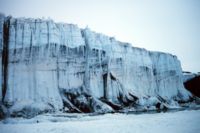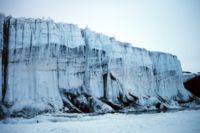Glaciers Erode Earth Faster than Rivers

Mountains owe their shapes to millions of years of gouging glaciers, eroding rivers, and shifting tectonic plates, but scientists have struggled to understand how these forces combine and how quickly they did their work.
Using a new technique, researchers have now documented how quickly glaciers eroded the spectacular mountain topography of the Coast Mountains of British Columbia.
For the past three years, Todd Ehlers of the University of Michigan has worked in a remote region of the Coast Mountains studying rates of glacial erosion and topographic change. Using a new geochemical tool developed by collaborating researchers at the California Institute of Technology, he and his team quantified the rates and magnitude of glacial erosion across a major valley.
They found that glaciers radically altered the landscape around 1.8 million years ago, about the time that Earth began to experience a number of ice ages.
Faster than rivers
The results suggest glaciers eroded the mountains six times faster than rivers and landslides had before glaciation began.
The researchers also found that glaciers scraped rock equal to at least 1.2 miles (2 kilometers) of depth out of the valley.
Sign up for the Live Science daily newsletter now
Get the world’s most fascinating discoveries delivered straight to your inbox.
"These results are exciting," Ehlers said, "because they clearly document that glaciers are the most efficient method for sculpting the topography of the range. They also demonstrate the utility of a new geochemical tool that can be applied to study erosion in other mountain ranges."
The work relied on a technique called helium-helium thermochronometry developed by Caltech's Ken Farley. It’s based on three facts: rocks on the surface have often come from beneath the surface; the ground gets steadily warmer as depth increases; helium leaks out of a warm rock faster than a cold one. By determining how fast the helium leaked out of a rock, it's also possible to determine how fast the rock cooled and, ultimately, how deeply it was buried, as well as when and how fast it got uncovered.
Quick work
The cooling of the rock happened very quickly in this case, and the entire valley was carved out in about 300,000 years.
"We can say that the glacier was ripping out a huge amount of material and dumping it into the ocean," Farley said. "And rather than taking evidence from a single instant, we can for the first time see an integral of hundreds of thousands of years. So this is a new way to get at the rate at which glaciers do their work."
Why the intense erosion occurred 1.8 million years ago is not well understood, said study co-author David Shuster, "but it seems to coincide with some very interesting changes that took place in Earth's climate system at that time."
The research was detailed in the Dec. 9 issue of the journal Science.
- Image Gallery: Ice of the Antarctic
- Mountain Building Quicker than Thought
- Columbia Glacier Decline Reaches Mid-way Point
- Runaway Glacier May Portend Rising Seas
Glacier Facts

Front of a melting glacier.
Credit: NOAA/Giuseppe Zibordi
About 10 percent of Earth's land is covered with glaciers.
During the last Ice Age, glaciers covered 32 percent of land.
Glaciers store about 75 percent of the world's fresh water.
Antarctic ice is more than 2.6 miles (4,200 meters) thick in some areas.
If all land ice melted, sea level would rise approximately 230 feet (70 meters) worldwide.
SOURCE: NOAA










